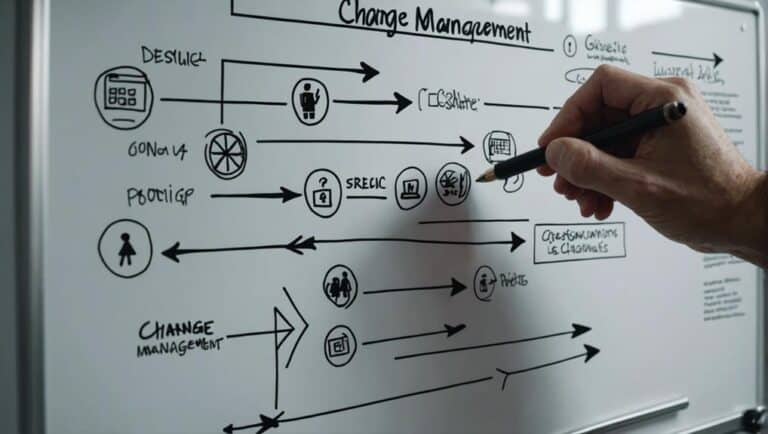Change management is a process that helps organizations successfully transition from one state to another, but anyone can handle that right? Why do you need a dedicated change manager?
A change manager ensures that everyone involved in the project understands how their role fits into the overall scheme of things. They also ensure that each member of staff knows what their responsibilities are within the team. This helps them to work together effectively and efficiently.
If you’re considering implementing changes within your company, large or small, then you’ll need to give serious thought to bringing on a change manager. This person will be responsible for ensuring that the changes are executed smoothly and efficiently, with as little impact on productivity as possible.
Change managers can help with everything from developing and implementing change management plans to leading and coordinating teams during a change initiative. They can also provide valuable support and guidance during times of transition.
Benefits of having a change manager on your team include:
- Improved communication and coordination
- Reduced stress and anxiety
- Increased clarity and direction
- Greater buy-in and support for change
- Enhanced team productivity
- And more!
Without a change manager overseeing things, it’s all too easy for projects to get off track quickly and end up being significantly delayed or even fail altogether.
On the other hand, having someone in charge who understands how to manage change effectively can make all the difference between a successful implementation and a complete disaster.
What is a change manager?
A change manager is someone who manages change in their workplace. They ensure that changes are implemented smoothly and effectively. Change managers typically work with other people within an organization.
They are responsible for leading, planning, and implementing change initiatives. They also help people adapt to new ways of working and living.
It can be a huge responsibility, they have to work with business leaders and will often be tasked with implementing changes that adjust the company culture, a structured approach is key to success.
They typically have previous experience in business, management or technical areas and are responsible for helping to facilitate the smooth transition from one state to another in an organization.
Additionally, a change manager can help identify and manage risks associated with any changes made to an organization.

What are the roles and responsibilities of a change manager?
A change manager is responsible for leading the charge during times of transition, ensuring that everyone is on board with the changes and that the goals are met in a timely and efficient manner.
Without a change manager, it can be difficult to implement new processes or procedures effectively, which can lead to frustration and confusion amongst employees.
Having a dedicated Change Manager ensures that there is clear communication and coordination throughout periods of change, making for a smoother transition for all involved.
Change management is one of the most challenging aspects of any organization. Change managers play an essential role in helping organizations successfully implement changes.
Here are 10 key roles and responsibilities that every change manager must perform.
Create a Vision Statement
Before implementing a change initiative, it’s critical to clearly define the vision of the organization. This helps everyone understand the direction of the organization and its goals.
It also provides a clear framework for the implementation of the change initiative.
Identify Stakeholders
Every change initiative involves stakeholders. They include employees, customers, suppliers, investors, and others.
Stakeholder analysis is the first step in understanding these individuals’ motivations and expectations.
This information is used to develop strategies and tactics to ensure stakeholder support.
Develop a Plan
After identifying stakeholders, developing a plan is the next step. This plan details exactly what the change initiative entails and how it will be implemented.
It outlines the timeline for each phase of the change initiative and identifies milestones that will be achieved along the way.

Communicate the Plan
Communication with employees is another crucial aspect of successful change initiatives. And by employees, we mean all levels, not just senior management.
Communication ensures that stakeholders understand the rationale behind the change initiative and the benefits associated with it.
Developing an effective communication strategy will ensure accurate information and education for stakeholders about the initiative.
Effective communication also includes communicating regularly and frequently.
Manage Resistance
An inevitable consequence of any change initiative is resistance. However, resistance should not derail the change initiative.
Managing resistance is a major responsibility of the change manager; they must identify and address issues early on to avoid unnecessary delays.
See also: The Fear of Change
Monitor Progress
Monitoring progress is another vital part of managing change. The management team may have a set of expectations for the results of any management initiatives, but do they match up to reality?
A change manager needs to measure success and failure against the original objectives of the change initiative, using tools such as key performance indicators (KPIs). If the change initiative fails to achieve its objectives, he/she must adjust accordingly.
Evaluate Results
Evaluating results is another important responsibility of the change manager, especially after the completion of the change initiative.
Key stakeholders will want to understand whether the change was successful and will expect the change manager to evaluate the impact of the change initiative on the organization.
Evaluation will make use of KPIs, staff and customer surveys, financial monitoring etc.

Prepare for Next Steps
Preparing for future steps is yet another responsibility of the change manager after completing the change initiative.
For example, if the change initiative failed to achieve its objectives, then the change manager must prepare for the next steps.
These may include retraining programs, reallocating resources, and adjusting organizational structure.
Review Lessons Learned
Reviewing lessons learned is another responsibility of the change leader.
Regardless of the outcome, they will review the successes and failures of the change initiative to improve upon the process for future change initiatives.
Sharing these lessons learned can be a valuable exercise for the key people involved in the project and may help highlight business processes that need reviewing.
Take Responsibility
Finally, taking full ownership of the change initiative is another responsibility of the person leading the change effort.
It is likely they will work across a range of departments who do not directly report to them, but via stakeholder management any issues or problems should be highlighted, so they can be dealt with.
Effective change management is all about communication; if they don’t get that right and something goes wrong they must accept accountability and take responsibility for the outcomes of the change initiative.
How do you know if you need a Change Manager?
As your company grows, so will the number of potential changes that could take place – new product launches, mergers and acquisitions, relocations…the list goes on.
If these changes are not managed properly they can quickly lead to chaos within an organization which is why having a dedicated Change Manager on staff becomes increasingly important as companies grow larger and scope.
Some indications that you might need a change manager include if your organization has struggled in the past with managing change, if there have been instances where important projects have not gone as planned or if stakeholders are openly resistant to change.
Additionally, it can be helpful to consider factors such as how successful your current team is in bringing about change and whether you feel like you could benefit from additional assistance in this area.
Fortunately you don’t need to hire hundreds of them; a single person dedicated to the roll (either a hired member of staff or a management consultant) can have a positive impact and increase the likelihood of success.
How Does Change Management Planning Tie into the Role and Responsibilities of a Change Manager?
Change management planning is crucial to the role of a change manager. The change management planning definition involves identifying, assessing, and preparing for changes within an organization. A change manager is responsible for overseeing this process, ensuring that any transitions are implemented smoothly and effectively.
Final thoughts
In conclusion, while some may see Change Management as simply “herding cats”, the truth is it’s much more than that. It’s about safeguarding your business against costly disruptions by implementing best practices for dealing with change at every level.
Change management is a hot topic amongst managers in today’s business world. A change manager is defined as “a professional who helps an organization transform by employing practices and processes that protect it against risks and enable growth.” So why do you need a change manager?
If your company experiences rapid growth, there will be an increased number of changes taking place within the organization – new product launches, mergers and acquisitions, relocations…the list goes on.
If these changes are not managed properly they can quickly lead to chaos within the company. This is where having a dedicated Change Manager on staff becomes increasingly important.
The Change Manager will help safeguard the business against costly disruptions by implementing best practices for dealing with change at every level.





